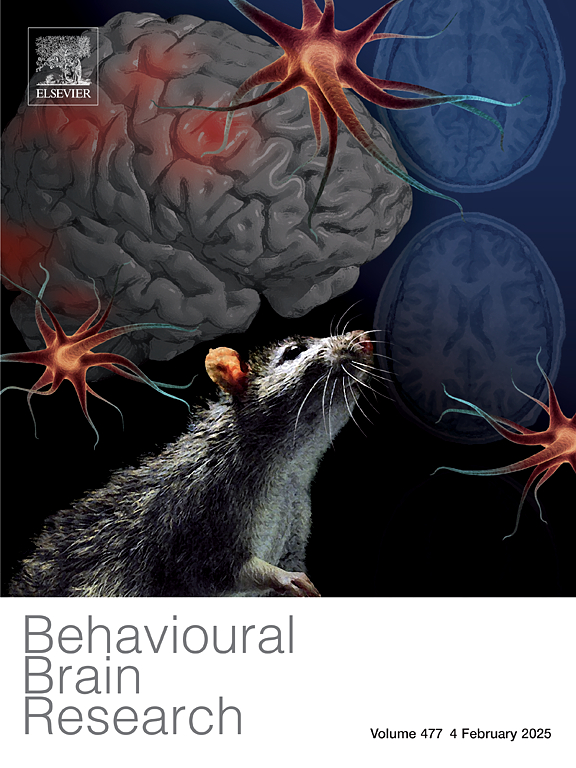Increased tyrosine hydroxylase abundance in the ventral tegmental area after taste-immune associative learning with saccharin or sucrose in rats
IF 2.3
3区 心理学
Q2 BEHAVIORAL SCIENCES
引用次数: 0
Abstract
Several animal studies have already demonstrated classical conditioning of immune responses, when a novel sweet solution was paired with the administration of an immunosuppressive drug. However, since sweet solutions are known to have an impact on central dopamine synthesis, their “neutrality” as conditioned stimuli has been questioned. In particular, it is not clear whether even re-exposure to water is sufficient to influence central dopamine synthesis when animals are on a specific fluid-restricted conditioning schedule and whether re-exposure to saccharin or sucrose has similar or different effects. To address this, we conducted a taste-immune associative learning study in rats, using saccharin or sucrose and the immunosuppressive drug fingolimod. Subsequently, we analyzed central tyrosine hydroxylase (TH) abundance and phosphorylation (pTH) to indirectly assess dopamine production. Moreover, we measured central monoamine oxidase A (MAO-A) abundance, thereby gaining information of possible immediate conversion of synthesized dopamine. Western blot analyses of the ventral tegmental area revealed no differences in pTH abundance among fluid-restricted rats that received either water, sucrose, saccharin or fingolimod. However, TH abundance was significantly increased in animals re-exposed to sucrose and saccharin compared to those given water. MAO-A abundance did not differ between groups. Analyses of the abundance and phosphorylation of dopamine-associated enzymes in the ventral and dorsal striatum, showed no differences between groups. These exploratory findings suggest that the consumption of sucrose and saccharin may be more rewarding than water consumption, when rats are maintained on a specific fluid-restricted conditioning schedule. However, further research is necessary to draw precise conclusions.
大鼠与糖精或蔗糖的味觉免疫联想学习后腹侧被盖区酪氨酸羟化酶丰度增加。
一些动物研究已经证明了经典的免疫反应条件反射,当一种新的甜溶液与免疫抑制药物配对时。然而,由于已知甜味溶液对中枢多巴胺合成有影响,它们作为条件刺激的“中立性”受到了质疑。特别是,当动物处于特定的液体限制调节计划时,甚至再次暴露于水是否足以影响中枢多巴胺合成,以及再次暴露于糖精或蔗糖是否具有类似或不同的影响,目前尚不清楚。为了解决这个问题,我们在大鼠中进行了一项味觉免疫联想学习研究,使用糖精或蔗糖和免疫抑制药物fingolimod。随后,我们分析了中心酪氨酸羟化酶(TH)丰度和磷酸化(pTH)来间接评估多巴胺的产生。此外,我们测量了中枢单胺氧化酶A (MAO-A)的丰度,从而获得了合成多巴胺可能立即转化的信息。腹侧被盖区的Western blot分析显示,在接受水、蔗糖、糖精或fingolimod的液体限制大鼠中,pTH丰度没有差异。然而,再次暴露于蔗糖和糖精的动物的TH丰度明显高于给予水的动物。各组间MAO-A丰度无差异。对腹侧纹状体和背侧纹状体中多巴胺相关酶的丰度和磷酸化的分析显示,两组之间没有差异。这些探索性发现表明,当大鼠保持特定的液体限制条件时,蔗糖和糖精的消耗可能比水的消耗更有益。然而,要得出准确的结论,还需要进一步的研究。
本文章由计算机程序翻译,如有差异,请以英文原文为准。
求助全文
约1分钟内获得全文
求助全文
来源期刊

Behavioural Brain Research
医学-行为科学
CiteScore
5.60
自引率
0.00%
发文量
383
审稿时长
61 days
期刊介绍:
Behavioural Brain Research is an international, interdisciplinary journal dedicated to the publication of articles in the field of behavioural neuroscience, broadly defined. Contributions from the entire range of disciplines that comprise the neurosciences, behavioural sciences or cognitive sciences are appropriate, as long as the goal is to delineate the neural mechanisms underlying behaviour. Thus, studies may range from neurophysiological, neuroanatomical, neurochemical or neuropharmacological analysis of brain-behaviour relations, including the use of molecular genetic or behavioural genetic approaches, to studies that involve the use of brain imaging techniques, to neuroethological studies. Reports of original research, of major methodological advances, or of novel conceptual approaches are all encouraged. The journal will also consider critical reviews on selected topics.
 求助内容:
求助内容: 应助结果提醒方式:
应助结果提醒方式:


